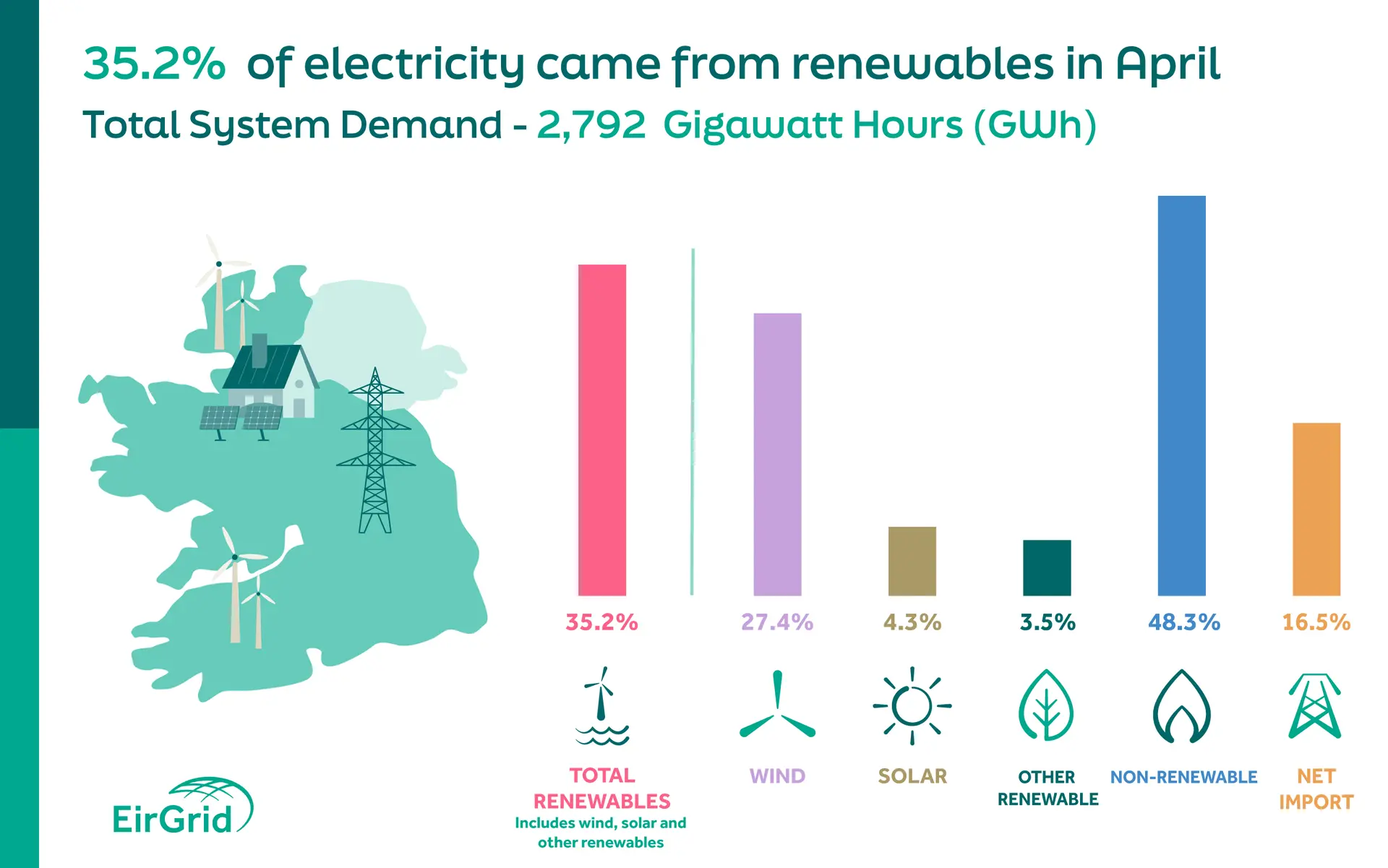More than a third of Ireland’s electricity came from Renewables in April
More than a third of Ireland’s electricity came from renewable energy sources in April as demand fell to the lowest level since September.
Ireland used a total of 2,792 GWh (Gigawatt Hours) of electricity in April as the winter peak began to pass.
Renewable energy sources accounted for a total of 35.2% of this consumption last month, with wind energy leading the way, but also a strong month for solar as we head into the summer.
- Wind Energy: 27.4%
- Solar Power: 4.3%
- Other Renewables: 3.5%
The solar energy figures only account for utility scale solar farms, and do not include the vast amount of rooftop solar panels on homes and businesses around the country.
Diarmaid Gillespie, Director of System Operations at EirGrid, said, “We’re seeing the demand profile for electricity change somewhat as the warmer weather and longer days reduces the need for heating and lighting.”

The only other month since last September with less than 3,000 GWh of demand was in February, several days shorter than other months. In comparison, November saw a total 30-day demand of 3,010 GWh.
As forecast in EirGrid’s annual Winter Outlook report, electricity demand was strong across this period, with peak demand passing the 6,000 MW (Megawatt) mark for the first time on 8 January during a particularly cold period.
Megawatt (MW) values provide snapshots of electricity demand at a particular moment in time, whereas Gigawatt Hours (GWh) reflects electricity use over a longer period.
“As we come towards summer, we’ll continue to rely on a mix of generation sources to maintain a stable supply of power on the electricity grid,” Diarmaid Gillespie said.
Gas remained the largest source of electricity in Ireland last month, accounting for 41.% of total electricity generation, with electricity imported via interconnection meeting another 16.5% of demand.
More than a third of Ireland’s electricity came from Renewables in April
Published: May 12, 2025
Last updated: October 8, 2025

Written by: Briain Kelly
Reading time: 1mins
More than a third of Ireland’s electricity came from renewable energy sources in April as demand fell to the lowest level since September.
Ireland used a total of 2,792 GWh (Gigawatt Hours) of electricity in April as the winter peak began to pass.
Renewable energy sources accounted for a total of 35.2% of this consumption last month, with wind energy leading the way, but also a strong month for solar as we head into the summer.
- Wind Energy: 27.4%
- Solar Power: 4.3%
- Other Renewables: 3.5%
The solar energy figures only account for utility scale solar farms, and do not include the vast amount of rooftop solar panels on homes and businesses around the country.
Diarmaid Gillespie, Director of System Operations at EirGrid, said, “We’re seeing the demand profile for electricity change somewhat as the warmer weather and longer days reduces the need for heating and lighting.”

The only other month since last September with less than 3,000 GWh of demand was in February, several days shorter than other months. In comparison, November saw a total 30-day demand of 3,010 GWh.
As forecast in EirGrid’s annual Winter Outlook report, electricity demand was strong across this period, with peak demand passing the 6,000 MW (Megawatt) mark for the first time on 8 January during a particularly cold period.
Megawatt (MW) values provide snapshots of electricity demand at a particular moment in time, whereas Gigawatt Hours (GWh) reflects electricity use over a longer period.
“As we come towards summer, we’ll continue to rely on a mix of generation sources to maintain a stable supply of power on the electricity grid,” Diarmaid Gillespie said.
Gas remained the largest source of electricity in Ireland last month, accounting for 41.% of total electricity generation, with electricity imported via interconnection meeting another 16.5% of demand.
Solar Energy Saves Households Thousands in Electricity Costs
Take our 2-minute questionnaire and find affordable solar options to suit your budget and lifestyle.



